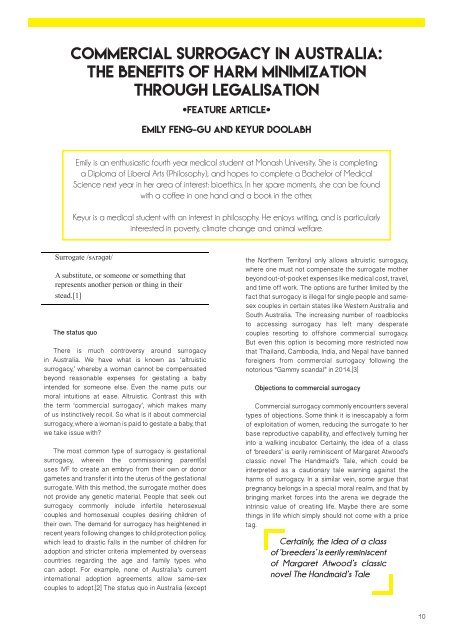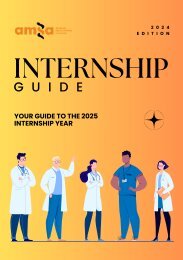Vector Volume 11 Issue 2 - 2017
You also want an ePaper? Increase the reach of your titles
YUMPU automatically turns print PDFs into web optimized ePapers that Google loves.
Commercial surrogacy in Australia:<br />
the benefits of harm minimization<br />
through legalisation<br />
[Feature Article]<br />
Emily Feng-Gu and Keyur Doolabh<br />
Emily is an enthusiastic fourth year medical student at Monash University. She is completing<br />
a Diploma of Liberal Arts (Philosophy), and hopes to complete a Bachelor of Medical<br />
Science next year in her area of interest: bioethics. In her spare moments, she can be found<br />
with a coffee in one hand and a book in the other.<br />
Keyur is a medical student with an interest in philosophy. He enjoys writing, and is particularly<br />
interested in poverty, climate change and animal welfare.<br />
Surrogate /sʌrəɡət/<br />
A substitute, or someone or something that<br />
represents another person or thing in their<br />
stead.[1]<br />
The status quo<br />
There is much controversy around surrogacy<br />
in Australia. We have what is known as ‘altruistic<br />
surrogacy,’ whereby a woman cannot be compensated<br />
beyond reasonable expenses for gestating a baby<br />
intended for someone else. Even the name puts our<br />
moral intuitions at ease. Altruistic. Contrast this with<br />
the term ‘commercial surrogacy’, which makes many<br />
of us instinctively recoil. So what is it about commercial<br />
surrogacy, where a woman is paid to gestate a baby, that<br />
we take issue with?<br />
The most common type of surrogacy is gestational<br />
surrogacy, wherein the commissioning parent(s)<br />
uses IVF to create an embryo from their own or donor<br />
gametes and transfer it into the uterus of the gestational<br />
surrogate. With this method, the surrogate mother does<br />
not provide any genetic material. People that seek out<br />
surrogacy commonly include infertile heterosexual<br />
couples and homosexual couples desiring children of<br />
their own. The demand for surrogacy has heightened in<br />
recent years following changes to child protection policy,<br />
which lead to drastic falls in the number of children for<br />
adoption and stricter criteria implemented by overseas<br />
countries regarding the age and family types who<br />
can adopt. For example, none of Australia’s current<br />
international adoption agreements allow same-sex<br />
couples to adopt.[2] The status quo in Australia (except<br />
the Northern Territory) only allows altruistic surrogacy,<br />
where one must not compensate the surrogate mother<br />
beyond out-of-pocket expenses like medical cost, travel,<br />
and time off work. The options are further limited by the<br />
fact that surrogacy is illegal for single people and samesex<br />
couples in certain states like Western Australia and<br />
South Australia. The increasing number of roadblocks<br />
to accessing surrogacy has left many desperate<br />
couples resorting to offshore commercial surrogacy.<br />
But even this option is becoming more restricted now<br />
that Thailand, Cambodia, India, and Nepal have banned<br />
foreigners from commercial surrogacy following the<br />
notorious “Gammy scandal” in 2014.[3]<br />
Objections to commercial surrogacy<br />
Commercial surrogacy commonly encounters several<br />
types of objections. Some think it is inescapably a form<br />
of exploitation of women, reducing the surrogate to her<br />
base reproductive capability, and effectively turning her<br />
into a walking incubator. Certainly, the idea of a class<br />
of ‘breeders’ is eerily reminiscent of Margaret Atwood’s<br />
classic novel The Handmaid’s Tale, which could be<br />
interpreted as a cautionary tale warning against the<br />
harms of surrogacy. In a similar vein, some argue that<br />
pregnancy belongs in a special moral realm, and that by<br />
bringing market forces into the arena we degrade the<br />
intrinsic value of creating life. Maybe there are some<br />
things in life which simply should not come with a price<br />
tag.<br />
Certainly, the idea of a class<br />
of ‘breeders’ is eerily reminiscent<br />
of Margaret Atwood’s classic<br />
novel The Handmaid’s Tale<br />
10

















